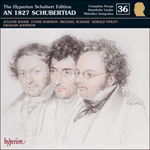
Welcome to Hyperion Records, an independent British classical label devoted to presenting high-quality recordings of music of all styles and from all periods from the twelfth century to the twenty-first.
Hyperion offers both CDs, and downloads in a number of formats. The site is also available in several languages.
Please use the dropdown buttons to set your preferred options, or use the checkbox to accept the defaults.

| Juliane Banse (soprano), Graham Johnson (piano)» More |
from notes by Graham Johnson © 1990
 Schubert: The Complete Songs Schubert: The Complete Songs‘This would have been a massive project for even the biggest international label, but from a small independent … it is a miracle. An ideal Christ ... ‘Please give me the complete Hyperion Schubert songs set—all 40 discs—and, in the next life, I promise I'll "re-gift" it to Schubert himself … fo ...» More |
 Schubert: The Hyperion Schubert Edition, Vol. 36 - Juliane Banse, Lynne Dawson, Michael Schade & Gerald Finley Schubert: The Hyperion Schubert Edition, Vol. 36 - Juliane Banse, Lynne Dawson, Michael Schade & Gerald Finley‘Superb … Wonderfully fluent, confident singing from Finley, soft-grained intimacy from Banse … a delight’ (Gramophone) ‘Elegant performances’ (BBC Music Magazine)» More |

